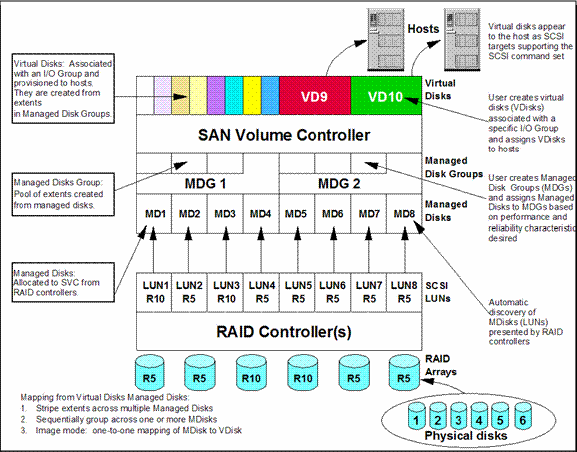| Tool Mentor: SVC – Assign and Control Delivery Resources |
 |
|
| Related Elements |
|---|
ContextTool mentors explain how a tool can perform tasks, which are part of ITUP processes and activities. The tasks are listed as Related Elements in the Relationships section. You can see the details of how processes and activities are supported by this tool mentor, by clicking the links next to the icons: DetailsThe SAN Volume Controller (SVC) is designed to simplify your storage area network (SAN) based disk storage management through virtualization. SVC combines the capacity from multiple heterogeneous disk storage systems into a single storage pool, which can be managed from a central point. The virtualized storage systems can be an IBM® or non-IBM tiered storage environment to better allow you to match the cost of the storage to the value of your data. The SAN Volume Controller is designed to:
The basic problemStorage needs are rising and the challenge of managing disparate storage systems is growing. Many business environments see a storage growth rate of over 50 percent per year. Business applications running across multiple operating systems are driving this growth. To provide value to the business, these applications must be highly available. The storage resources that these applications depend on are typically spread across storage systems from different vendors each with different costs, performance characteristics, and unique management interfaces. Without the virtualization of these resources, it can be a very complex task to add or reallocate storage in a way that ensures application availability while matching the cost of storage to the value of data. It is complex because an administrator must be familiar with and interact with multiple management applications, each with its own isolated view of storage. There is also no easy way to migrate data between these different storage systems to maximize resource utilization without impacting the applications that depend on the storage. Complexity comes with increased management costs and the risk of error that can lead to application unavailability. If an application is unavailable it is not providing value, which is likely costing the business money in lost opportunity and idle resources. How SVC helps solve the problemSVC brings multiple storage systems together in a virtual pool to make all storage appear as one logical device that can be centrally managed. The controller presents virtual disks to host computers running a variety of operating systems. The fact that the disks are virtualized is completely transparent to the host computers; they see the virtual disks as if they were physical disks, and nothing special is needed on the host computer to leverage the centralized storage. SVC refers to the physical disks that are attached to it as managed disks. Managed disks are placed into managed disk groups based on cost, performance, and reliability characteristics. This allows you to easily match the characteristics of the underlying storage to the value of your data.
Figure 1: Relationship of the various storage components used with the SAN Volume Controller Administrators can better manage capacity and utilization to ensure high application availability. High and low cost disks can be added and used side-by-side providing a very flexible and cost-effective solution. Application data can be moved transparently and non-disruptively from one managed disk to another without impacting the host or applications that are using the virtual storage. Productivity is improved by allowing administrators to perform management functions when convenient rather than waiting for ever decreasing maintenance windows. Application downtime requirements are all but eliminated using this approach. SVC is clustered for high availability and scalable for performance. The controller is a set of clustered nodes which are grouped into pairs, called I/O groups, with a single pair being responsible for serving I/O on a given virtual disk. If a node (an individual computer) in the cluster is unavailable, or too busy to respond to a request for a resource, the request is transparently passed to another node capable of processing it. Although a cluster can have many nodes within it, the nodes handle I/O in independent pairs. This means that the I/O capability of the controller scales well (almost linearly), since additional throughput can be obtained by simply adding additional I/O groups. SVC supports centralized backup and data replication for business continuance and disaster recovery. By providing a logical view of physical storage, advanced functions like backup and disaster recovery can be done at a single point in the SAN in a consistent way regardless of the underlying physical storage. FlashCopy, Metro Mirror (formerly referred to as Peer-to-Peer Remote Copy [PPRC]), and data migration can also be performed in a consistent way. For example, a SAN volume controller can be installed at two different locations and Metro Mirror functionality can then be used to maintain a remote hot standby site ensuring that data is always available even if a disaster were to occur at the primary site. IBM's SVC enables storage virtualization. This allows clients to reap the benefits of better application business responsiveness, maximized storage utilization, dynamic resource allocation, improved storage administration utilization, and reduced storage outage. For more informationFor more information about this tool, see the IBM System Storage SAN Volume Controller tool. |
©Copyright IBM Corp. 2005, 2008. All Rights Reserved. |
